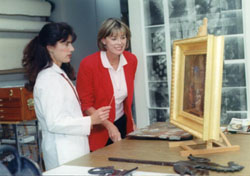Conservation of Cą d'Zan Chairs
 |
|
Research and conservation
assessment is underway at the Ringling Museum. In June, Susan Baldino traveled to Sarasota
with FSU photographer Bill Langford and videographer Tigger Gray to document progress of
academic activity at the museum. Susan, Bill and Tigger joined museum staff and
FSU-Ringling interns to hear Michelle Scalera, Chief Conservator, talk about her work in
the museum conservation lab. Along with a video presentation on conserving paintings and
objects, Michelle showed some of the work in progress. Especially interesting was a
colorful chair from Cą d'Zan, part of John and Mable Ringling's furnishings in their
mansion on the bay.
One of a pair, the chair is a 19th-century work in the style of Louis XIV from the John
Jacob Astor Mansion. The historical importance of the chairs and their provenance prompted
Michelle Scalera to consult with Paul Miller, curator from the Newport Preservation
Society. Miller helped make the attribution and discussed the original tone of the gilded
finish. As Scalera recounts, "There was such severe loss on the finish, it had to be
totally investigated and we wanted it to be looked at by someone who had the expertise of
historic homes," The chairs are believed to be by a French furniture maker from
Paris, Jules Allard et Fils. |
Wanting to be associated with such society figures as the
Astors, Mrs. Ringling bought the chairs at auction in 1926 for her new home, Cą d'Zan.
| Probably the most interesting undertaking during
conservation of the chairs was the recreation of the colorful patterned seats and backs
that had suffered years of neglect since they had been created for Mrs. Ringling in the
1920s. For four years, volunteers from the Embroiderers Guild of America and the American
Needlepoint Guild worked for 3500 painstaking hours. "We had women here every day,
working on the seat and back covers for the chairs-21 stitchers in all. It was a very
happy experience," says Scalera, |
|
 |
"They were some of America's finest stitchers. Staff
members and museum trustees would come in to watch the work, all being reminded of a
mother or aunt or someone from the past creating beauty with needlework. At the conclusion
of their work, we missed 'our women,' as we called these wonderful stitchers."
Only two stitchers worked at a time on the loom, or
"scrim" as it is called. They had no pattern from which to copy so they had to
count stitches and create their own pattern for the recreation of the original. It was
faithful inasmuch as it could be; however, the petit point birds and squirrels done by
Marguerite Crosby, project coordinator, were slightly embellished to make an even more
beautiful pattern. The stitchers used laine Colbert (French tapestry wool) in 35 colors.
The DMC Corp of Secaucus NJ donated all the wool, which is consistent with the original
materials.
DMC Corp of Secaucus NJ, donated all the wool, tapestry
wool used in tapestry conservation, consistent with original materials. With new seats and
backs, the chairs are ready to be re-placed in the Court, the heart of Cą d'Zan on the
main level of the mansion.
ringlingdocents.org
|

